For the better part of two decades, the intro sequence for the BBC’s primetime Saturday night show, Strictly Come Dancing (known as Dancing with the Stars in the U.S.), has been produced by Creative Nuts, a small motion graphics studio in Spitalfields, East London.
Specializing in branding and idents for broadcast, Creative Nuts was founded in 2006 by Creative Directors, Piers Helm and Stephanie Porter. Before starting his career with the BBC, Helm earned a degree in print design and advertising at Maidstone College of Art and spent a few years working as a freelancer. We spoke with Helm about how Strictly Come Dancing’s title sequence has evolved from using a kaleidoscope effect created by filming a mirror ball to being nearly fully CG, using Cinema 4D and Octane.

Steve Jarratt: How did you get the job doing the Strictly Come Dancing intro sequence?
Piers Helm: I was asked to pitch for the first series way back, 17 years ago. At the time, I was head of design at a company in Convent Garden called Skaramoosh, and a couple of clients I’d worked for previously were developing a new show, Strictly Come Dancing, and they invited me to pitch. I think an internal BBC team pitched too, as well as a few other companies, but I was fortunate enough to win that pitch.
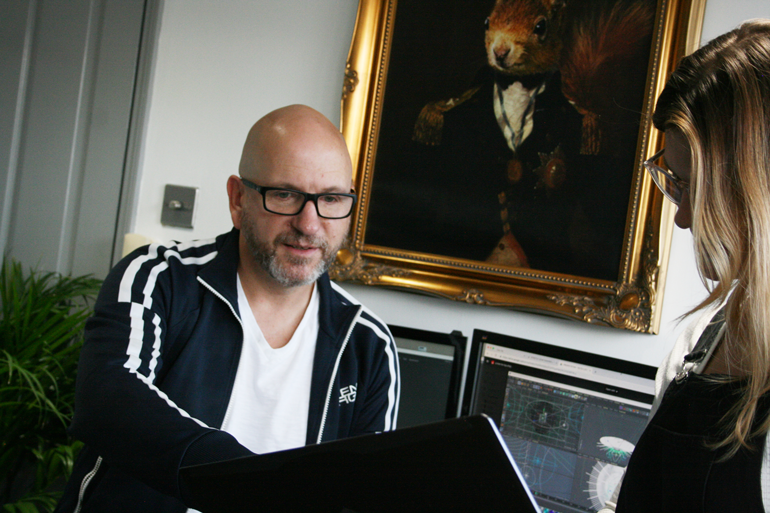
SJ: You were up against some pretty stiff competition. How did you get it?
PH: I think it was down to the visuals for the sequence, as well as the logo, which was based on a mirror ball, a motif that’s still used across all of the international versions of the format. Originally, they didn’t think of having the celebrities in the titles. But once we developed the storyboard to feature the couples, we have re-filmed it and built it from scratch every year.
The original titles used a 2D kaleidoscope effect, which was slightly cheesy and ‘70s, but it worked brilliantly for this because you could take one dancing couple, and it would turn them into a whole troupe of formation dancers. The backgrounds were created using footage of a real mirror ball that I filmed on Beta SP, together with vintage curtains and glitter all put through the kaleidoscope too. It’s funny how it’s gone from that to being mainly computer generated, apart from the people of course.
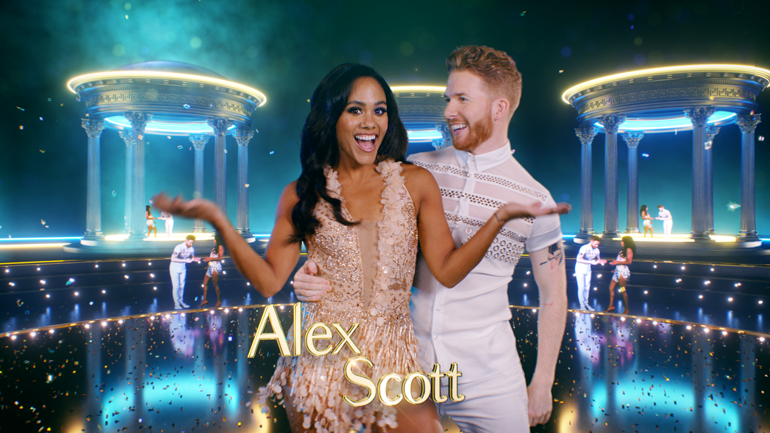
SJ: What were you using before Cinema 4D?
PH: Being a veteran in the industry, I was on a computer graphics workstation called Quantel HAL, which predates C4D and even Adobe. When I started using C4D, I was still using Quantel, but it was a natural progression to After Effects because of the need to import the camera. Originally, we shot the titles on tape in SD, and then we went to HD, shooting on Betacam. Next we used a disc camera, and now it’s all digital media. I try to update things and do something different every year. It’s a perfect job for a designer because it’s never finished; I’m always thinking about what I’m going to do for the following year.
I transitioned to Cinema 4D in the seventh series. I was trying to do something new. I’d played around a bit on Cinema 4D R11. I always like throwing myself into the deep end, so I thought, ‘Well, let’s go for it.’ The first one was fairly basic. It was just shapes for a set I built with steps and arches and stuff, repeated around in the background. I actually used a couple of optical flares that were inside Cinema 4D, and I used MoGraph cloners create multiple dancers.

SJ: What did you do in 2019 to push things even more?
PH: In 2019, I decided to get away from the greens of the previous years. I experimented with blues and purple, and then added radial neon lines together with an explosion of glass squares. It’s flattering to see that the BBC has continued the color scheme to the set and lighting. Neon details have also been added in the backgrounds to freshen up the look. In addition to Cinema 4D, I’m now using Octane Render, which makes it easier and faster to do glass and neon.
The original setup I had was Cinema 4D together with a small render farm, which was something like six render nodes, all CPU-based. I think on each node, render times on the mirror ball logo were about 25 minutes per frame. So I’d have to leave it for almost a whole day to do a loop of 250 frames. Now, with Cinema 4D R21 and Octane, I’ve got it down to about a minute per frame.
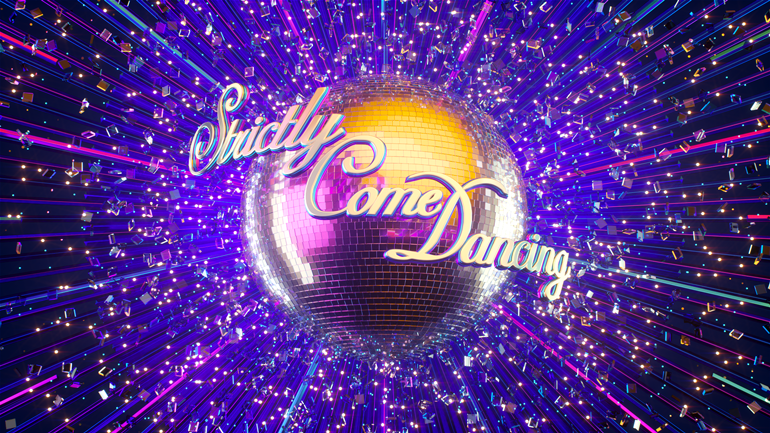
SJ: Once you’ve shot the couples on green screen how are they added to a sequence?
PH: It’s done in After Effects using Primatte or Keylight. Then, for the background dancers, I do a basic key and put them within the scene in Cinema 4D. I do it that way so I can light them, and that works well with reflections. The whole thing is basically the MoGraph cloner. I take one arch and repeats it around in a circle, and then I do the same with the background dancers. I create the end logo and stings in advance, but the dancer scenes have to be built, textured and lit after the shoot because that’s the first time I get to see the outfits and colours.
A couple of years ago, I was filming them using a moving camera on a semi-circular track, and then doing camera tracking to match the backgrounds with the movement. Then, I realised that each shot is so short, you don’t really notice if it’s just the scenery spinning so we don’t track anymore, which is good because we don’t have a lot of time to do this. Once I’ve filmed the couples, I have three weeks until the program is on air. I’ve got to work pretty fast, and I need something I can work fast on, get it rendered, composited and signed off.
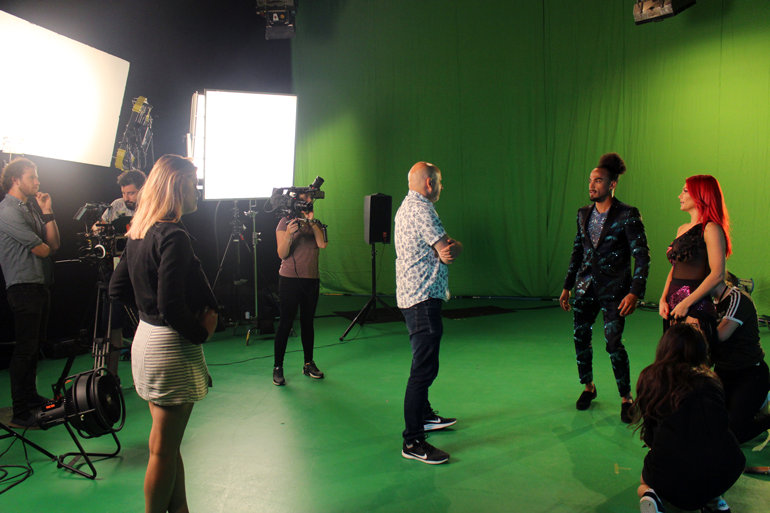
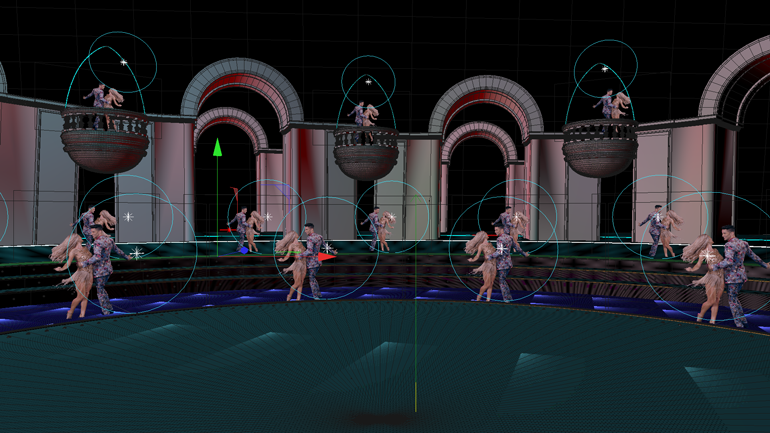
SJ: How much do you do in-camera in C4D?
PH: As much as I can. The background plane is a whole thing that’s comped together. I used to have lots of different passes that I could layer. But the best thing about Octane, in particular, is that it comes out pretty much as I want it. Before, with glows and reflections, you’d have to do composites in After Effects to get it looking good. With Octane, if it’s a good scene, I can just grade it slightly, or bring out some of the highlights, or add some lens flares here and there. Then I’ve got a background plane that I pre-render as a 4K animation, and I composite the foreground dancers on top of that. My secret weapon is a pass using C4D standard render volumetric lights, which is essential for creating the smoky atmospherics in the scenes.
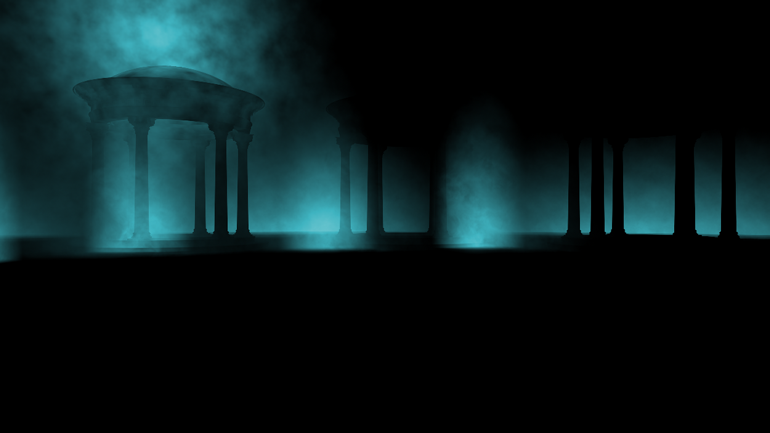
SJ: Are you doing many more elements than you were ten years ago?
PH: Yes. In addition to the main title sequence, I also create stings, wipes and a graphics package for the lower third and scoring. I also do specials in the series, like Halloween and Movies Week, which need bespoke logos, as well as the final show and a Christmas Special, which has its own look and title sequence. Really, from September to December every year I have mirror balls coming out of my ears.